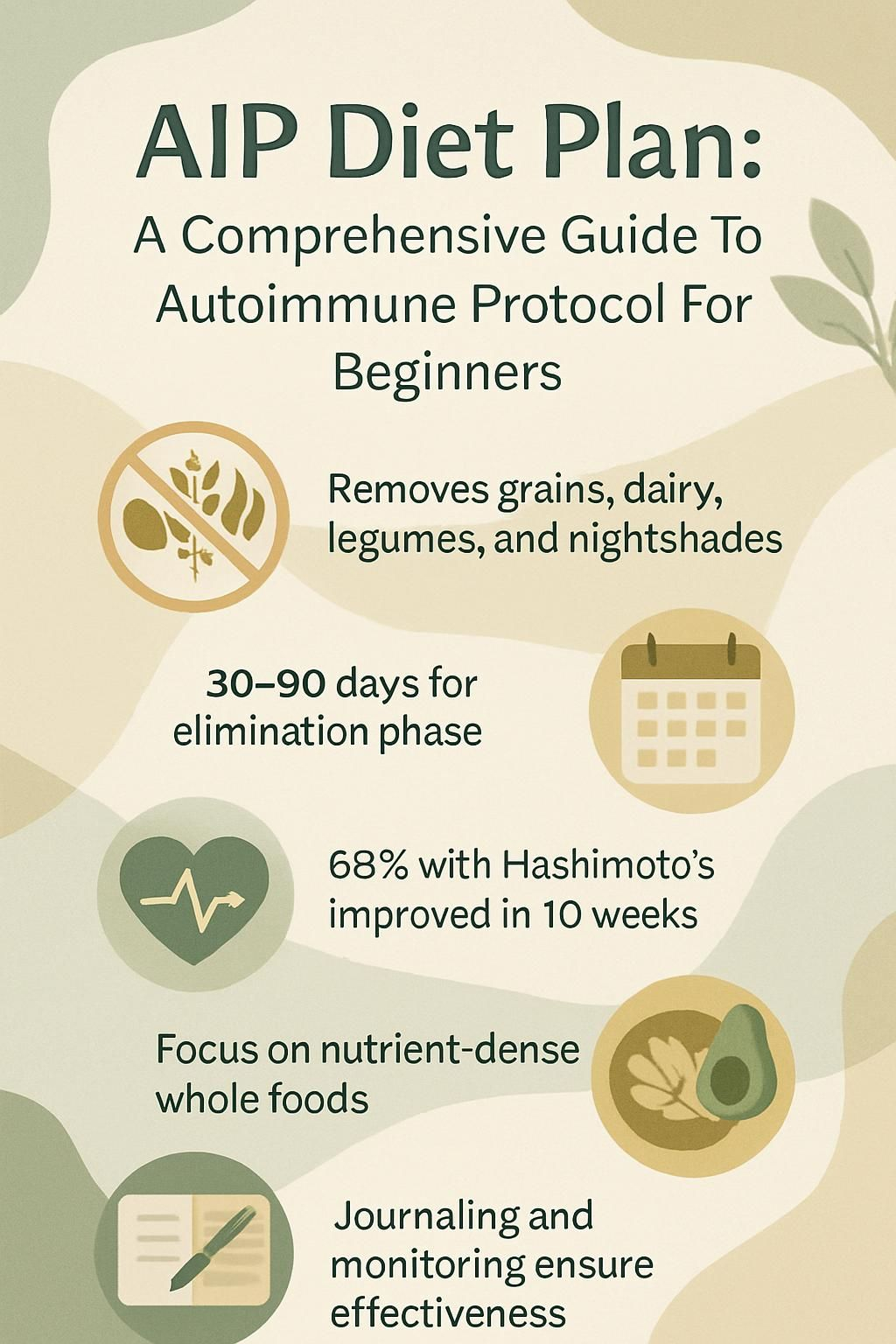AIP Diet Plan: A Comprehensive Guide To Autoimmune Protocol For Beginners
Our Nutrition Assistant AI Suite will transform your body. You will lose fat, get toned, and build muscle. Gain confidence and optimal health.
If you live with pain, fatigue, or stomach problems from an autoimmune disease, food choices can shape how you feel. The AIP diet, short for Autoimmune Protocol, is a structured elimination diet that removes common triggers and focuses on calming inflammation.
This beginner-friendly guide explains how the plan works, which foods to eat or avoid, and how to start without overwhelm. You will see the phases, sample meals, and practical tips to help you use food as a tool for symptom relief.
If you want a plan that targets root triggers, keep going. Small steps on the plate can add up to better days.
Key Takeaways
- The AIP Diet is a structured elimination plan used to ease autoimmune symptoms. It removes grains, dairy, legumes, nightshades, processed foods, and artificial additives.
- Most people follow an elimination phase for 30 to 90 days, then reintroduce foods one at a time over five to seven days.
- Small studies show benefits. In Hashimoto’s thyroiditis, up to 68 percent reported symptom relief in ten weeks. Some research also noted a 29 percent drop in inflammation markers.
- Nutrient-dense staples include grass-fed and wild-caught meats, organ meats, bone broth, non-nightshade vegetables, fermented vegetables, and limited fresh fruit.
- Planning meals, tracking symptoms, and working with a healthcare professional help prevent nutrient gaps and improve results.

What is the Autoimmune Protocol (AIP) Diet?

The Autoimmune Protocol, or AIP diet, is a targeted elimination diet for conditions like lupus, inflammatory bowel disease, celiac disease, and rheumatoid arthritis. An elimination diet removes a set of foods for a period to assess symptom changes and then adds foods back in a careful way.
During AIP you avoid foods linked to immune reactions or gut irritation. That list includes eggs, nuts and seeds, nightshade vegetables like tomatoes and potatoes, grains, dairy, legumes such as beans and soy, processed food with additives or artificial sweeteners, and refined sugars. It is stricter than the paleo diet because it excludes more groups.
The main goal is to reduce inflammation and support gut health. Many people with autoimmune disease have higher intestinal permeability, often called leaky gut. While evidence is still growing, early studies and clinical experience suggest AIP can help some people feel better.
Some try less restrictive plans first, such as a paleo or low FODMAP approach, then move to AIP if symptoms persist.
Autoimmune disorders cause your immune system to attack healthy cells. A structured elimination diet can help you find food triggers and manage symptoms.
Understanding the Phases of the AIP Diet
The AIP diet uses three phases to identify trigger foods and support healing. You remove likely irritants, then reintroduce foods in a methodical way, and finally personalize your long-term plan.
What Happens During the Elimination Phase?
In the elimination phase, you remove foods most likely to drive inflammation or gut irritation. That includes grains, legumes, dairy, eggs, nuts, seeds, nightshades like tomatoes, peppers, and eggplant, processed vegetable oils such as canola or soybean oil, food additives, alcohol, coffee, processed sugars, tobacco, and protein powders.
Your AIP diet food list centers on whole foods. Choose minimally processed meats like grass-fed beef or wild-caught fish, non-nightshade vegetables, limited fruit, bone broth, fermented foods, and offal such as liver. Some versions allow up to 12 servings of fruit per day, though many people do better with less.
Most people follow this phase for 30 to 90 days. Some notice changes within three weeks. Alongside food changes, focus on stress management, regular movement, and quality sleep, because these factors influence immune balance.
Once your symptoms calm and stabilize, you can plan the next step, reintroduction.
How Does the Reintroduction Phase Work?
After symptoms improve, you begin testing single foods again to learn your personal triggers. Space each trial by at least five to seven days so reactions are clear.
Many start with ghee and fermented dairy, then try egg yolks, seed oils, peas, green beans, and seed or fruit spices. Use a careful sequence for each food:
- First taste: 1 teaspoon, then wait 15 minutes.
- If no reaction, try 1.5 tablespoons, then wait 2 to 3 hours.
- If still fine, eat a normal portion once, then avoid it for 5 to 6 days while you watch for symptoms.
Avoid testing foods during illness, high stress, or poor sleep. A food journal helps you link specific items to reactions such as bloating, rashes, or joint pain. Keep foods that cause no symptoms and set aside those that flare issues.
What Is the Maintenance Phase Like?
Maintenance is about long-term fit. You keep foods that work for you and skip the ones that do not. For many, this phase becomes similar to a paleo diet with personal adjustments.
Check in with a registered dietitian if possible. Periodic reviews can prevent nutrient gaps and help you respond to health changes. Over time you fine-tune your plan to lower flares and support steady energy.
Personalization is key in the maintenance phase; what works for one person may not work for another.
Which Foods Are Allowed on the AIP Diet?
The AIP diet features nutrient-dense whole foods that support recovery. Think of it as filling your plate with options that lower your body’s stress, not raise it.
Why Choose Grass-fed and Wild-caught Meats?
Grass-fed and wild-caught meats provide high-quality protein with fewer additives. They often contain more omega-3 fats, which may help lower inflammation, plus more iron and B vitamins than highly processed meats.
Some plans suggest up to nine servings of pasture-raised or wild meats daily, balanced with abundant vegetables. Avoid processed meats to limit preservatives and hidden sweeteners. This choice supports an anti-inflammatory menu while meeting your protein needs.
What Are the Benefits of Organ Meats and Bone Broth?
Organ meats such as liver, heart, and kidney are rich in vitamin A, iron, zinc, copper, selenium, and B vitamins. Including them once or twice per week can help prevent deficiencies during elimination.
Bone broth offers collagen and amino acids that support the gut lining. Many people sip broth or use it in soups and stews. Fermented foods may also help your gut microbiota, the community of bacteria that aid digestion and immunity.
These foods fit the whole-food focus of AIP and support nutrient density while you avoid common triggers.
Which Non-nightshade Vegetables Can You Eat?
Non-nightshade vegetables anchor the plan. They deliver fiber, minerals, and antioxidants that support the gut and immune system.
- Leafy greens like kale, spinach, and Swiss chard. Aim for several servings daily.
- Cruciferous vegetables such as broccoli, cauliflower, cabbage, and Brussels sprouts.
- Root vegetables like sweet potatoes, yams, carrots, parsnips, turnips, beets, and rutabaga. Regular potatoes are nightshades, so skip them in elimination.
- Artichokes for magnesium and potassium, plus prebiotic fiber.
- Squashes like butternut, acorn, zucchini, and pumpkin.
- Onions and garlic for flavor and antioxidants.
- Fermented vegetables, for example sauerkraut or pickled carrots, to add probiotics.
- Sea vegetables like nori and kelp for minerals, including iodine and magnesium.
- Choose fresh, organic produce when possible to reduce pesticide exposure.
Many people report less bloating and steadier energy when plates are built around these vegetables.
What Fruits Are Permitted on the AIP Diet?
Fruits can fit well, but portion control matters. Whole fruit provides fiber that slows sugar absorption.
- Good choices include berries, apples, pears, and melons.
- Most do well with about two servings per day during elimination.
- Some programs allow more, up to 12 servings per day, though this is not typical. Ask your clinician before increasing.
- Choose whole fruit, not juice or dried fruit, to avoid sugar spikes.
- Skip seed-derived spices and additives in fruit products during elimination.
- Prefer local or organic fruit to limit pesticides.
- Track your response. For example, some find bananas easier during digestive flares than citrus.
Knowing what to avoid next will help you apply the plan with confidence.
What Foods Should You Avoid on the AIP Diet?
Some foods are more likely to irritate the gut or trigger the immune system. Removing them during elimination gives you a clearer picture of what your body tolerates.
Why Exclude Grains and Legumes?
Grains such as wheat, rice, oats, barley, and rye, and legumes like lentils, beans, peas, peanuts, soy products, and tofu can stress a sensitive gut. Gluten in wheat, barley, and rye can provoke an immune response in some people. Compounds in legumes, such as lectins and phytates, may irritate the gut lining and block nutrient absorption.
Many people report fewer gut issues after removing grains and legumes, especially those with autoimmune conditions.
What Issues Do Dairy and Nightshade Vegetables Cause?
Dairy from cow, goat, or sheep, including milk, cheese, yogurt, butter, cream, and ghee, can trigger bloating or skin irritation. Even low-lactose options often remain out during elimination.
Nightshade vegetables include potatoes, tomatoes, eggplant, and peppers, including paprika. Their natural alkaloids can irritate digestion for some people. If your symptoms calm, you can test them later during reintroduction.
Why Avoid Processed Foods and Additives?
Processed foods commonly contain emulsifiers, preservatives, artificial colors, and trans fats. These can disturb gut balance and increase inflammation. Artificial sweeteners and flavor enhancers may also affect your microbiota and gut lining.
Choosing whole foods removes many of these unknowns. Many people notice fewer flares when packaged snacks leave the cart.
What Are the Risks of Sugars and Artificial Sweeteners?
Refined sugars such as soda, candy, and corn syrup can spike blood sugar and drive inflammation. Added sugars including cane sugar and brown rice syrup, and sugar substitutes like stevia and xylitol, are not part of elimination.
Even natural sweeteners, like honey or maple syrup, are best kept small. Artificial sweeteners may change gut bacteria in ways that worsen symptoms. Cutting added sugars often reduces headaches and energy dips.
How Does the AIP Diet Improve Health?
The AIP diet aims to calm an overactive immune system and support gut repair. For many, reducing triggers means fewer flares and better daily function.
How Does It Reduce Inflammation?
Removing grains, dairy, nightshades, added sugars, and processed foods eliminates common irritants. In a 10 week pilot trial in Hashimoto’s thyroiditis, inflammation markers dropped by 29 percent as participants followed the protocol. Some people notice less joint pain and fatigue within three weeks.
Skipping artificial sweeteners and additives reduces ongoing immune stress, which can help your body reset.
In What Ways Does It Enhance Gut Health?
The plan avoids foods linked to leaky gut, a term for increased intestinal permeability. It emphasizes bone broth, fermented vegetables, and diverse non-nightshade produce to support the gut lining and microbiota.
Small studies in inflammatory bowel disease show better mucosal healing and quality of life after several weeks on a plan modeled on AIP principles. A calmer gut often means calmer symptoms.
Can It Relieve Autoimmune Symptoms?
Many people report fewer flares and steadier energy after 10 to 12 weeks. In one small study, up to 68 percent of those with Hashimoto’s said symptoms improved by week ten. People with IBD also reported better quality of life by week twelve.
If you see little change after several weeks, triggers may lie outside food. At that point, check sleep, stress, and medications with your care team.
How Does It Promote Overall Wellness?
Filling your plate with nutrient-dense foods supports stable energy and mental clarity. Along with meal changes, AIP encourages better sleep and regular movement. Many people also report lower anxiety once symptoms settle.
Support groups, planning tools, and brief check-ins with a clinician help maintain progress.
What Challenges Might You Face on the AIP Diet?
The plan is strict at first. You may face social stress, limited restaurant options, and a learning curve in the kitchen. Planning ahead keeps it doable.
How to Address Nutritional Deficiencies?
Elimination can limit certain nutrients. Smart choices and monitoring help keep your levels steady while you test foods.
- Eat a wide mix of non-nightshade vegetables daily to cover vitamins and minerals.
- Add organ meats, such as liver, at least once per week for iron and B12.
- Choose grass-fed beef and wild-caught fish for omega-3 fats and trace minerals.
- Use bone broth several times per week for collagen and minerals like calcium and magnesium.
- Include fermented foods such as sauerkraut or coconut yogurt to add probiotics and extra micronutrients.
- Track your intake and symptoms in a journal to spot gaps early.
- Ask your clinician for blood work to assess B12, thiamine, calcium, iron, and vitamin D if needed.
- Use targeted supplements under medical guidance if a deficiency shows up.
- Reintroduce tolerated foods after elimination to widen your menu and lower future risk of deficiency.
These steps reduce the chance of low energy, hair shedding, or anemia as you follow the plan.
What Does Strict Commitment Entail?
Success depends on consistency. Follow the elimination rules for at least two to three weeks, often up to 90 days. That means no grains, dairy, legumes, nightshades, added sugars, artificial sweeteners, processed foods, or alcohol.
Social events may be tricky at first. Plan ahead with meals, read labels closely, and keep compliant snacks handy. Support from a dietitian or online community boosts your odds of staying on track.
Why Do Results Vary Among Individuals?
Genes, stress, sleep, microbiota diversity, and disease severity all affect outcomes. Two people with the same diagnosis can respond very differently to the same plan.
Consistency also matters. Skipping steps or eating low quality foods reduces benefits. Set realistic goals and adjust with your clinician as you learn what your body tolerates.
How Can You Succeed on the AIP Diet?
You can use the AIP diet to help manage symptoms and build long-term habits. Planning, tracking, and support make the process smoother.
How to Plan Meals and Prep in Advance?
Planning removes guesswork on busy days. A little time each week can protect your progress.
- Write a weekly menu using AIP friendly foods like grass-fed meats, bone broth, and non-nightshade vegetables.
- Shop once per week to stock your fridge and freezer.
- Keep recipes simple during elimination, five ingredients or fewer works well.
- Batch cook proteins and freeze single portions for quick meals.
- Prep snacks, for example apple or pear slices with coconut flakes.
- Pack leftovers in insulated containers for school or work.
- Use trusted meal planning tools to track reintroductions later.
- Schedule a weekly prep block for chopping, roasting, and assembling salads.
- Keep a list of family favorite AIP meals to repeat often.
- Consult a registered dietitian experienced with elimination diets for balance and variety.
Why Keep a Food Journal?
A food and symptom journal helps you connect dots. You record what you eat, how you slept, stress levels, and any reactions. This makes reintroduction clearer and helps your clinician tailor advice.
Over time, your notes become a personal map of triggers and safe foods.
Where to Find Support from Communities or Dietitians?
Join online groups such as Bezzy for shared tips and encouragement. Many forums and social channels host active AIP communities where you can ask questions, swap recipes, and learn from others’ experiences.
Work with a registered dietitian who knows the autoimmune protocol. Some clinics offer one-on-one coaching and lab monitoring during elimination and maintenance. Professional guidance reduces risk and helps you adjust the plan as life changes.
Next, explore sample menus to see how a typical AIP day can look.
Sample AIP Diet Meal Plans
These simple menus show how to build balanced plates that fit the rules. Use them as templates you can rotate and tweak.
What Are Some Meal Ideas for Day 1?
Breakfast: grass-fed beef patty with sautéed kale and sweet potato. This gives protein, iron, and slow carbs.
Lunch: roast chicken breast over mixed greens like spinach or arugula with olive oil and lemon. Skip grains and nightshades.
Snack: sliced apple with coconut flakes.
Dinner: baked salmon with steamed broccoli and a mug of bone broth.
Beverages: water or herbal tea. Dessert: a small serving of berries. For dressing, try apple cider vinegar, olive oil, and herbs without seed based spices.
What Are Some Meal Ideas for Day 2?
Breakfast: turkey sausage with sautéed spinach and artichoke. That combo supports iron status and energy.
Lunch: lamb stew with carrots, celery, and bone broth for collagen and minerals.
Snack: pear slices with unsweetened coconut yogurt.
Dinner: grilled wild-caught fish and roasted Brussels sprouts with garlic. Add green tea if you tolerate it well.
Dessert: a small portion of melon or another allowed fruit. Use fresh herbs like parsley or thyme for flavor.
Keep reading for more variety on day three.
What Are Some Meal Ideas for Day 3?
Breakfast: chicken liver pâté with sautéed Swiss chard and sweet potato hash. This provides heme iron and vitamin A.
Lunch: bison burger wrapped in lettuce with a cucumber radish salad. Coconut aminos make a soy free seasoning.
Snack: fermented sauerkraut and carrot sticks for probiotics and crunch.
Dinner: roast duck with asparagus and a cup of bone broth.
Beverages: water or unsweetened herbal infusions. Dessert: sliced peach or apple. Many people find this menu calming during elimination.
Selected sources: Ballantyne S, The Paleo Approach, 2014. Konijeti GG et al., AIP in Hashimoto’s thyroiditis, 2019.
Common Questions About the AIP Diet
Here are clear answers to frequent questions, based on current evidence and clinical experience.
How Long Does the Elimination Phase Last?
Most people follow elimination for 30 to 90 days. Some feel better within three weeks. This window gives your immune system a break from likely triggers so you can judge changes before reintroducing foods.
Track pain, digestion, skin, and energy along the way. These notes are your guide to the next phase.
Is the AIP Diet Effective for Different Autoimmune Disorders?
Early research suggests AIP may help some conditions, including inflammatory bowel disease and Hashimoto’s thyroiditis. Results depend on your unique triggers and how closely you follow the plan.
Work with a registered dietitian to meet nutrient needs. Larger trials are still needed, so stay flexible and monitor progress with your clinician.
How Does the AIP Diet Compare to the Paleo Diet?
AIP is stricter than the paleo diet. Both remove grains, dairy, and most processed foods, but AIP also excludes eggs, nuts, seeds, and nightshades during elimination. AIP uses defined phases and a careful reintroduction process, while paleo allows more variety from the start.
Because AIP limits more potential triggers, some people with autoimmune disease report better control on AIP than on paleo.
What Are the Potential Risks of the AIP Diet?
A strict plan can feel isolating in social settings, and long eliminations can raise the risk of nutrient gaps if not well planned. Evidence is still limited for many autoimmune conditions, and results vary widely.
Summary of risks:
| Risk Factor | Impact |
|---|---|
| Highly restrictive | Social challenges and emotional stress |
| Prolonged elimination | Increased risk of nutrient deficiencies |
| Limited research | Uncertain effectiveness across all conditions |
| Varied results | Some individuals see few or no improvements |
Professional guidance can help you avoid pitfalls, balance nutrition, and reintroduce foods safely. This is especially important for pregnancy, teenagers, and people with multiple food sensitivities.
Should You Try the AIP Diet?
AIP may be worth trying if you want to explore food triggers and calm inflammation. It removes common irritants, focuses on nutrient density, and uses a careful reintroduction to build a personalized plan.
Partner with your healthcare professional to prevent deficiencies and track lab markers if needed. While research is still developing, many people find meaningful relief. If medications change, or if symptoms persist, adjust your approach with your care team.
Conclusion
The AIP diet gives you a structured way to test food triggers, reduce inflammation, and support gut health. With planning, symptom tracking, and support, many people see fewer flares and better energy.
Start small, stay consistent, and work with a clinician if you can. Your goal is not perfection, it is learning which foods help you feel and function your best. This guide to the AIP diet can help you take the next step with clarity and care.
Medical disclaimer: This article is educational and is not a substitute for personalized medical advice. Always consult your healthcare professional before making major diet changes, especially if you take medication or have a chronic condition.
FAQs
1. What is the AIP diet plan and how does it help with autoimmune conditions?
The Autoimmune Protocol, or AIP diet plan, removes foods that may trigger inflammation in people with immune system disorders. Studies show this approach can reduce symptoms like joint pain and fatigue by focusing on nutrient-rich meats, vegetables, fruits, and healthy fats while excluding grains, dairy products, legumes, processed sugars, nuts, seeds, eggs, nightshade plants such as tomatoes and potatoes as well as food additives [1][2]. Many beginners report improved energy levels after several weeks.
2. Which foods are allowed on the AIP diet for beginners?
The protocol encourages eating fresh meats including fish; leafy greens; root vegetables except for white potatoes; berries; coconut products; olive oil; bone broth; fermented foods without added sugar or preservatives such as sauerkraut or kimchi. These choices provide vitamins and minerals needed to support immune health.
3. How long should someone follow the elimination phase of an AIP diet plan?
Most experts recommend following the strict elimination phase for at least 30 to 90 days before slowly reintroducing excluded items one at a time to identify triggers [3]. Keeping a detailed food journal during this period helps track reactions accurately.
4. Are there any risks linked to starting an AIP diet for those new to autoimmune protocols?
Some individuals may experience nutrient gaps if they do not eat enough variety within approved groups or fail to supplement when necessary [4]. Consulting a registered nutritionist ensures balanced intake of essential nutrients like calcium and vitamin D throughout all stages of the protocol.
Summary: The Autoimmune Protocol focuses on removing common inflammatory foods while emphasizing whole ingredients rich in nutrients. Following evidence-based guidelines supports symptom relief in many cases though professional guidance improves safety and effectiveness.
References:
[1] Ballantyne S., “The Paleo Approach,” Victory Belt Publishing.
[2] Abbott RD et al., Nutrients (2019), “Autoimmune Protocol Diet Modifies Clinical Disease Activity.”
[3] Konijeti GG et al., Inflammatory Bowel Diseases (2017).
[4] National Institutes of Health Office of Dietary Supplements: Calcium/Vitamin D Fact Sheets







